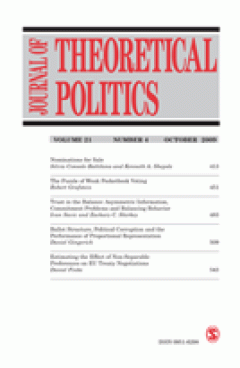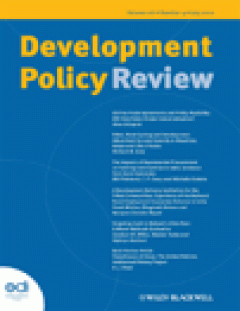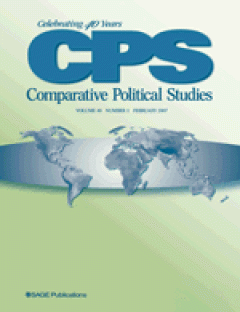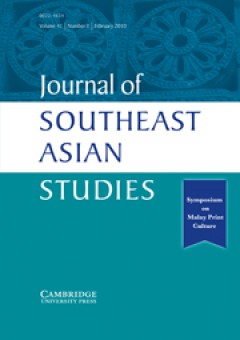Filter by

Three Worlds of Relief: Race, Immigration, and Public and Private Social Welf…
Using a data set of public and private relief spending for 295 cities, this article examines the racial and ethnic patterning of social welfare provision in the United States in 1929. On the eve of the Depression, cities with more blacks or Mexicans spent the least on social assistance and relied more heavily on private money to fund their programs. Cities with more European immigrants spent th…
- Edition
- Volume 116. No. 2, September 2010.pp. pp. 453-502
- ISBN/ISSN
- 00029602
- Collation
- -
- Series Title
- The American Journal of Sociology
- Call Number
- -

Industry Induces Academic Science to Know Less about More
How does collaboration between academic research and industry shape science? This article argues that companies' relative indifference to theory nudges their academic partners toward novel, theoretically unanticipated experiments. The article then evaluates this proposition using fieldwork, archival materials, and panel models of all academic research using the popular plant model Arabidopsis t…
- Edition
- Volume 116. No. 2, September 2010.pp. pp. 389-452
- ISBN/ISSN
- 00029602
- Collation
- -
- Series Title
- The American Journal of Sociology
- Call Number
- -

The Oncomouse That Roared: Hybrid Exchange Strategies as a Source of Distinct…
Conventional wisdom suggests that when institutional logics overlap, the production of hybrids signifies collapse, blending, or easy coexistence. The author provides an alternative interpretation: hybrids can maintain a distinctive boundary and can emerge from contestation, not coexistence. This alternative interpretation is grounded in an analysis of a critical moment at the academic?commercia…
- Edition
- Volume 116. No. 2, September 2010.pp. 341-388
- ISBN/ISSN
- 00029602
- Collation
- -
- Series Title
- The American Journal of Sociology
- Call Number
- -

How presidents push, when presidents win: A model of positive presidential po…
Presidents� positive role in US lawmaking is as ubiquitous as it is unclear. While a rich literature has identified many macro-level factors that constrain presidents� policymaking potential, still unanswered is Richard Neustadt�s micro-level question: how can presidents influence legislation given the context and Congress they happen to inherit? Developing a game theoretic model in which the p…
- Edition
- Vol. 23 no. 1, January 2011.pp. 3-20
- ISBN/ISSN
- 09516298
- Collation
- -
- Series Title
- Journal of Theoretical Politics
- Call Number
- -

Why primaries? The party’s tradeoff between policy and valence
Our theory studies why and when political parties choose to hold competitive primary elections. Party leaders can decide the nomination by granting resources and endorsements to a chosen candidate. Alternatively, they can delegate the candidate selection to the party�s rank and file by holding a primary election among multiple candidates. The benefit of a primary is to increase the expected val…
- Edition
- Vol. 23 no. 1, January 2011.pp. 21-51
- ISBN/ISSN
- 09516298
- Collation
- -
- Series Title
- Journal of Theoretical Politics
- Call Number
- -

Seizing the mantle of change: Modeling candidate quality as effectiveness ins…
In spatial models of electoral competition, candidate quality is typically modeled as valence, a measure of general appeal assumed to be constant across voters. This paper introduces and formally models an alternative conception of candidate quality according to which candidates differ in their effectiveness, or likelihood of changing policy from the status quo. Although more effective candidat…
- Edition
- Vol. 23 no. 1, January 2011.pp. 52-68
- ISBN/ISSN
- 09516298
- Collation
- -
- Series Title
- Journal of Theoretical Politics
- Call Number
- -

Optimal counterterrorism and the recruitment effect of large terrorist attack…
We analyze a simple dynamic model of the interaction between terrorists and authorities. Our primary aim is to study optimal counterterrorism and its consequences when large terrorist attacks lead to a temporary increase in terrorist recruitment. First, we show that an increase in counterterrorism makes it more likely that terrorist cells plan small rather than large attacks and therefore may i…
- Edition
- Vol. 23 no. 1, January 2011,pp. 69-86
- ISBN/ISSN
- 09516298
- Collation
- -
- Series Title
- Journal of Theoretical Politics
- Call Number
- -

Are group sources always credible? An experimental study of sources, stakes a…
When is mobilization of group identity successful? Work on social movements suggests that frames that target group identity can mobilize groups. However, this work does not address when group mobilization using frames is likely to be successful. Recent work on source credibility finds that same-group sources are an important moderator of framing effects, and previous work on stakes of the decis…
- Edition
- Vol. 23 no. 1, January 2011.pp. 87-110
- ISBN/ISSN
- 09516298
- Collation
- -
- Series Title
- Journal of Theoretical Politics
- Call Number
- -

Free-riding in international environmental agreements: A signaling approach t…
This paper examines countries� free-riding incentives in international environmental agreements (IEAs) when, first, the treaty is non-enforceable, and, second, countries do not have complete information about other countries� non-compliance cost. We analyze a signaling model whereby the country leading the negotiations of the international agreement can reveal its own non-compliance costs throu…
- Edition
- Vol. 23 no. 1, January 2011.pp. 111-134
- ISBN/ISSN
- 09516298
- Collation
- -
- Series Title
- Journal of Theoretical Politics
- Call Number
- -

The finagle point and the epsilon-core: A comment on Bräuninger’s proof
The finagle point, the epsilon-core, and the yolk are all predictors of majority-rule decision-making in spatial voting models. These predictors each minimize a radius needed in some sense to alter preferences so as to achieve stability. Brauninger showed that the finagle radius is never smaller than the epsilon-core radius, and claimed that the finagle point is within the epsilon core. This ar…
- Edition
- Vol. 23 no. 1, January 2011.pp. 135-139
- ISBN/ISSN
- 09516298
- Collation
- -
- Series Title
- Journal of Theoretical Politics
- Call Number
- -

State Fragility and Governance : Conflict Mitigation and Subnational Perspect…
An earlier version of this article was presented at the international workshop on �Global Effects and Local Dynamics of Intrastate Conflicts�, organised by the Leonard Davis Institute for International Relations, Hebrew University of Jerusalem and the Center for Advanced Study of International Development, Michigan State University, held in Jerusalem in May 2009. The author thanks the participa…
- Edition
- Volume 29, Issue 2, March 2011, pages 131–153
- ISBN/ISSN
- 09506764
- Collation
- -
- Series Title
- Development Policy Review
- Call Number
- -

Impacts of the Triple Global Crisis on Growth and Poverty : The Case of Yemen
This article is an output of the project �Poverty and food security strategy for Yemen� funded by the Ministry of Planning and International Cooperation (MOPIC) of Yemen with support from the European Commission (EC) and the World Bank. The authors gratefully acknowledge comments from Khaled Saeed, Merna Hassan, Samed Albori and Abdulmajeed Al-Bataly (MOPIC), Damien Buchon, T. G. Srinivasan, Na…
- Edition
- Volume 29, Issue 2, March 2011. pages 155–184
- ISBN/ISSN
- 09506764
- Collation
- -
- Series Title
- Development Policy Review
- Call Number
- -

Grants to Needy Countries? A Study of Aid Composition between 1975 and 2005
This article discusses whether the poorest and most indebted countries receive aid in the form of grants rather than loans, by studying bilateral aid flows to low- and middle-income countries between 1975 and 2005. The empirical analysis finds no evidence that more indebted countries receive a higher grant component, but it does show that poorer countries receive a significantly higher grant co…
- Edition
- Volume 29, Issue 2, March 2011, pages 185–209
- ISBN/ISSN
- 09506764
- Collation
- -
- Series Title
- Development Policy Review
- Call Number
- -

The Food Crisis and its Impacts on Poverty in Senegal and Mali: Crossed Desti…
This article uses two CGE macro-micro models to analyse the distributional impact of the food crisis and policy responses in two neighbouring African countries, both of which are strongly dependent on agriculture. The approach captures structural differences at both the macro and micro level for household income and expenditure structures, and the results reveal differences for poverty impact a…
- Edition
- Volume 29, Issue 2, March 2011, pages 211–247
- ISBN/ISSN
- 09506764
- Collation
- -
- Series Title
- Development Policy Review
- Call Number
- -

Navigating Institutional Change: The Accord, Rogernomics, and the Politics of…
This article uses a transactions approach to examine the ability of governments to develop and sustain negotiated solutions to major economic challenges. Where actors are embedded in long-term, repeated interaction, have long time horizons, and invest in monitoring and enforcement technologies, effective political exchange is more likely. In good transactions environments, policy bargains will …
- Edition
- Vol. 44 no. 2, February 2011.pp. 127-155
- ISBN/ISSN
- 00104140
- Collation
- -
- Series Title
- Comparative Political Studies
- Call Number
- -

Unlootable Resources and State Security Institutions in Tajikistan and Uzbeki…
Why, when faced with similar conditions of weakening central control, do some institutions of state security fragment into autonomous agents of organized violence whereas others cohere around coercive rent seeking without challenging the central government? Focusing on Tajikistan and Uzbekistan, this article explains these divergent state security outcomes as a consequence of resource concentra…
- Edition
- Vol. 44 no. 2, February 2011.pp. 156-183
- ISBN/ISSN
- 00104140
- Collation
- -
- Series Title
- Comparative Political Studies
- Call Number
- -

Revisiting the Party Paradox of Finance Capitalism: Social Democratic Prefere…
The �party paradox� thesis claims that in the context of the legal corporate governance reforms of the 1990s, which aimed at adjusting national corporate governance systems to the �finance capitalism� of the Anglo-American type, center-left parties promoted proshareholder corporate governance reforms, whereas center-right parties opposed such reforms. Based on case studies of Switzerland, Swede…
- Edition
- Vol. 44 no. 2, February 2011.pp. 184-210
- ISBN/ISSN
- 00104140
- Collation
- -
- Series Title
- Comparative Political Studies
- Call Number
- -

Political Institutions and Property Rights: Veto Players and Foreign Exchange…
What political institutions improve property rights? Building on the work of North and Weingast, this article argues that institutional checks on policy-making discretion (�veto players�) improve the property rights of investors regarding the value of the domestic currency. Veto players constrain the ability of policy makers to opportunistically pursue policy that may lead to a depreciated dome…
- Edition
- Vol. 44 no. 2, February 2011.pp. 211-240
- ISBN/ISSN
- 00104140
- Collation
- -
- Series Title
- Comparative Political Studies
- Call Number
- -

Slavery and cultural creativity in the Banda Islands
In his influential edited volume Slavery, bondage and dependency in Southeast Asia, Anthony Reid suggests that long-term slave-based systems of production were absent from agriculture in Southeast Asia, and had an ambiguous presence at best in other areas of economic activity. The argument he presents suggests that indigenous slavery in the region merged into a �kind of serfdom or household mem…
- Edition
- Volume 41, Number, 3, October 2010. pp. 365-389
- ISBN/ISSN
- 00224634
- Collation
- -
- Series Title
- Journal of Southeast Asian Studies
- Call Number
- -

The ‘informal Portuguese empire’ and the Topasses in the Solor archipelag…
This study of Timor and the surrounding islands between the sixteenth and eighteenth centuries provides evidence that, after the demise of the Portuguese Estado da India, an �informal� or �shadow� empire persisted but in uniquely localised ways. It describes the emergence of the �black Portuguese� community known in Timor and the Solor archipelago as the Topasses. Their singular identity was ba…
- Edition
- Volume 41, Number 3, October 2010.pp.391-420
- ISBN/ISSN
- 00224634
- Collation
- -
- Series Title
- Journal of Southeast Asian Studies
- Call Number
- -
 Computer Science, Information & General Works
Computer Science, Information & General Works  Philosophy & Psychology
Philosophy & Psychology  Religion
Religion  Social Sciences
Social Sciences  Language
Language  Pure Science
Pure Science  Applied Sciences
Applied Sciences  Art & Recreation
Art & Recreation  Literature
Literature  History & Geography
History & Geography